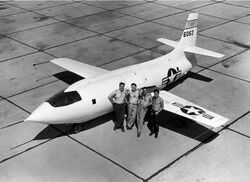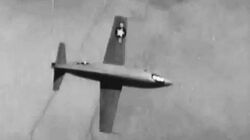
The #46-062 Bell X-1 rocket-powered experimental aircraft (known for becoming the first piloted aircraft to fly faster than Mach 1, or the speed of sound, on October 14, 1947) photographed during a test flight.
Background[]
Soviet designers working on ramjet conceptsin 1933, fired phosphorus-powered engines out of artillery guns to get them to operational speeds and tried out some unnamed vehicles, which broke the sound barrier that year.
A Spitfire PR Mk XI (PL965) was of the type used in the 1944 RAE Farnborough dive tests during which it got the highest Mach Number of 0.92, was obtained, but not officially recorded.
One of the highest recorded instrumented Mach Numbers attained for a propeller aircraft was the Mach 0.891 for a Spitfire PR XI flown during dive tests at the Royal Aircraft Establishment, Farnborough in April 1944. On 25 April 1945, Hans Guido Mutke landed at Dübendorf, Switzerland, flying the Me262A-1a jet fighter, 'White 3', from 9. Staffel,Jagdgeschwader 7. He claimed that he got lost during a combat mission and landed there by mistake, although there were suspicions that he'd defected. The Swiss authorities never attempted to fly the plane, keeping it in storage and returning it to Germany on 30 August 1957. He sued the post-war German government, unsuccessfully, for the return of the plane, claiming it was his own property.
Mutke also made the controversial claim that he broke the sound barrier in 1945 in an Me 262, but mainstream opinion continues to regard Chuck Yeager as the first person to achieve this milestone in 1947 in a Bell X-1. Some evidence presented by Mutke is on page 13 of the "Me 262 A-1 Pilot's Handbook" issued by Headquarters Air Materiel Command Wright Field, Dayton, Ohio as Report No. F-SU-1111-ND on January 10, 1946:
The Luftwaffe test pilot Lothar Sieber (April 7, 1922 - March 1, 1945) may have inadvertently become the first man to break the sound barrier on 1 March 1945. This occurred while he was piloting a Bachem Ba 349 "Natter" for the first manned vertical takeoff of a rocket in history. In 55 seconds, he traveled a total of 14 km (8.7 miles). The aircraft crashed and he perished violently in this endeavor.
In his 1990 book Me-163, former Messerschmitt Me 163 "Komet" pilot Mano Ziegler claims that his friend, test pilot Heini Dittmar, broke the sound barrier while diving the rocket plane, and that several people on the ground heard the sonic booms. He claims that on 6 July 1944, Dittmar, flying Me 163 B V18 VA + SP, was measured traveling at a speed of 1,130 km/h (702 mph). However, no evidence of such a flight exists in any of the materials from that period, which were captured by Allied forces and extensively studied.
Heini Dittmar, flying an early "Komet" prototype in 1941, reached an officially measured speed of 1,004 kph in level flight. This was probably around Mach .95, but classified until after the war and the udsed altitude is unknown. Another unofficial report claims that Dittmar hit 1,130 kph in 1944 (Mach 1.06), and another states that in a steep dive he created sonic booms that were heard on the ground.
In 1942, the United Kingdom's Ministry of Aviation began a top-secret project with Miles Aircraft to develop the world's first aircraft capable of breaking the sound barrier. The project resulted in the development of the prototype Miles M.52 turbojet powered aircraft, which was designed to reach 1,000 mph (417 m/s; 1,600 km/h) (over twice the existing speed record) in level flight, and to climb to an altitude of 36,000 ft (11 km) in 1 minute 30 sec.
After cancellation, the research was used to construct an unmanned missile that went on to achieve a speed of Mach 1.38, proving the idea to be scientifically valid.
The UK merged it's data and 90% complete project work in to the similar American project, also started in 1942, in 1944 on the promise of data and technology sharing after the Americans has started actual test flights and engine rig-up tests. They did share the information with the UK afterwards. If it had not had the British input then they would have probably not made it in 1947 and struggled on for several more years before going aloft.
George Welch with breaking the sound barrier in the XP-86 in a dive six months later on April 26, 1948, with official measurements and a proper Mach indicator on board.
Jackie Cochran was the first woman to break the sound barrier on May 18, 1953, in a Canadair Sabre, with Yeager as her wingman.
By the 1950s, new aircraft designs routinely "broke" the sound barrier.
The idea[]

The Bell X-1-2.
The Bell X-1, was originally designated as XS-1, was a joint National Advisory Committee for Aeronautics-U.S. Army Air Forces-U.S. Air Force supersonic research project built by the Bell Aircraft Company. They wanted to investigate high altitude and high speed flight technology. The sound barrier was a new and scary phenomena first found in the late 1930s.
Development[]
In 1942, the United Kingdom's Ministry of Aviation began a top secret project with Miles Aircraft to develop the world's first aircraft capable of breaking the sound barrier. The project resulted in the development of the prototype turbojet-powered Miles M.52, designed to reach 1,000 miles per hour (870 kn; 1,600 km/h) (over twice the existing airspeed record) in level flight, and to climb to an altitude of 36,000 ft (11 km) in 1 min 30 sec.
The UK merged it's data and 90% complete project work in to the similar American project, also started in 1942, in 1944 on the promise of data and technology sharing after the Americans has started actual test flights and engine rig-up tests. They did share the information with the UK afterwards. If it had not had the British input then they would have probably not made it in 1947 and struggled on for several more years before going aloft.
Some aspects of the wing and tail shapes were different on the American model. The British wing tips were "clipped" to keep them clear of the conical shock wave generated by the nose of the aircraft.
Later variants of the X-1 were built to test different aspects of supersonic flight; one of these, the X-1A, with Yeager at the controls, inadvertently demonstrated a very dangerous characteristic of fast (Mach 2 plus) supersonic flight: inertia coupling. Only Yeager's skills as an aviator prevented disaster; later Mel Apt would lose his life testing the Bell X-2 under similar circumstances.
The Mission[]
It was a fist of it's kind and very cutting edge for 1947. Chuck Yeager made the first supersonic that year in it, but the other test pilots soon, followed suit. These flights were also to set a new altitude record. They wanted to investigate high altitude and high speed flight technology. The sound barrier was a new and scary phenomena first found in the late 1930s.
The aircraft it's self[]

The #46-062 Bell X-1 rocket-powered experimental aircraft (known for becoming the first piloted aircraft to fly faster than Mach 1, or the speed of sound, on October 14, 1947) photographed during a test flight.
It was a strong, aerodynamically shaped, sleek, metallic, rocket partly like entity like the North American X-15. The X-15 fuselage was long and cylindrical; with a pointed, aerodynamic cockpit and nose cone at the front and with a stubby tail at the back. The fuselage was slightly wider where conventionally shaped reinforced wings were mounted on it.
Later variants of the X-1 were built to test different aspects of supersonic flight; one of these, the X-1A, with Yeager at the controls, inadvertently demonstrated a very dangerous characteristic of fast (Mach 2 plus) supersonic flight: inertia coupling. Only Yeager's skills as an aviator prevented disaster; later Mel Apt would lose his life testing the Bell X-2 under similar circumstances.
Stats[]
- Engine type: Reaction Motors XLR11.
- First flight: January 19, 1946.
- Made in: USA.
- Nationality: American.
- Crew: one.
- Length: 30 ft 11 in (9.4 m).
- Wingspan: 28 ft (8.5 m).
- Height: 10 ft (3.3 m).
- Wing area: 130 ft² (12 m²).
- Empty weight: 7,000 lb (3,175 kg).
- Loaded weight: 12,225 lb (5,545 kg).
- Max. takeoff weight: 12,250 lb (5,557 kg).
- Powerplant: one × Reaction Motors XLR-11-RM3 liquid-propellant rocket, 6,000 lbf (1,500 lbf per chamber) (26.7 kN) each.
- Maximum speed: 957 mph (Mach 1.26) (1,541 km/h).
- Range: five minutes (powered endurance).
- Service ceiling: 71,902 ft (21,916 m).
- Wing loading: 94 lb/ft² (463 kg/m²).
- Thrust/weight: 0.49.
- Specifications for: (Bell X-1).
- Role: Experimental rocket plane.
- Manufacturer: Bell Aircraft Company.
- First flight: 19 January 1946.
- Status: Retired.
- Primary users: U.S. Air Force and the National Advisory Committee for Aeronautics.
- Number built: 4 (1 cancelled).
Videos[]

First Supersonic Flight "Breaking the Sound Barrier" 1947 USAF; Chuck Yeager in the Bell X-1
Silent but detailed documentary of Chuck Yeager making the first supersonic flight in the Bell X-1 "Glamorous Glennis" on October 14, 1947.

X-1 Rocketplane "Glamorus Glennis"
Bell X-1 was the first manned aircraft that oficially broke the sound barrier in 1947. Although there are many earlier reports from various sources, including Nazi Germany, that sound barrier was broken before the X-1 flight, Chuck Yeager is still regarded as the first pilot achieving this goal. The aircraft was nicknamed "Glammorous Glennis" after Chuck Yeager's (the pilot) wife. It was powered by RMI XLR-11 series rocket engine providing 26,7 kN of thrust. The airplane itself was shaped after the 12,7mm rifle bullet, being the only aerodynamically stable shape in supersonic conditions known to US scientists in those days.

Bell X-1 Plane
Bell X-1 plane -- joint supersonic research project between NACA, U.S. Army and U.S. Air Force. Silent video footage. X-1 released from mothership, in flight, and landing on the dry lakebed at Edwards AFB / Dryden.
Also see[]
- Bell Textron Rocket Belt
- North American X-15
- Bell Rocket Belt
- Avro Flying Car
- Bell Jet Belt
- Bell Helli-vector
- Bell Helli-jeep
- Moor 1969 Jet Pack
- Bell Pogo
- KGB Chita Jet Belt
- Small Rocket Lift Device (SRLD)
- RB2000 Rocket Belt
- Lockheed X-17
- North American X-15
- Lockheed X-17
- Chuck Yeager
- American X-aircraft
- Missiles
Online links[]
- https://en.wikipedia.org/wiki/Bell_X-1
- http://www.space.com/26204-chuck-yeager.html
- https://en.wikipedia.org/wiki/North_American_F-86_Sabre#Breaking_sound_barrier_and_other_records
- https://unitedcats.wordpress.com/2008/11/25/historical-footnote-on-march-1st-1945-did-lothar-sieber-become-the-first-person-to-break-the-sound-barrier/
- https://skeptoid.com/episodes/4154
- http://www.waa.ca/blog/post/636/who-was-the-first-canadian-pilot-to-break-the-sound-barrier
- https://en.wikipedia.org/wiki/Sound_barrier
- https://en.wikipedia.org/wiki/George_Welch_(pilot)
- https://en.wikipedia.org/wiki/Hans_Guido_Mutke
- https://skeptoid.com/episodes/4154